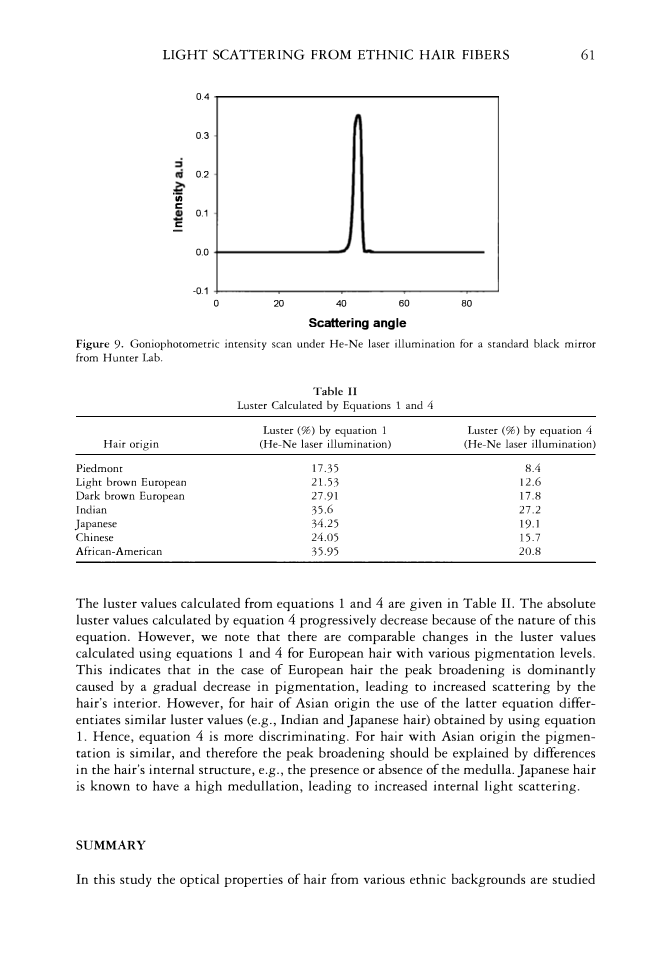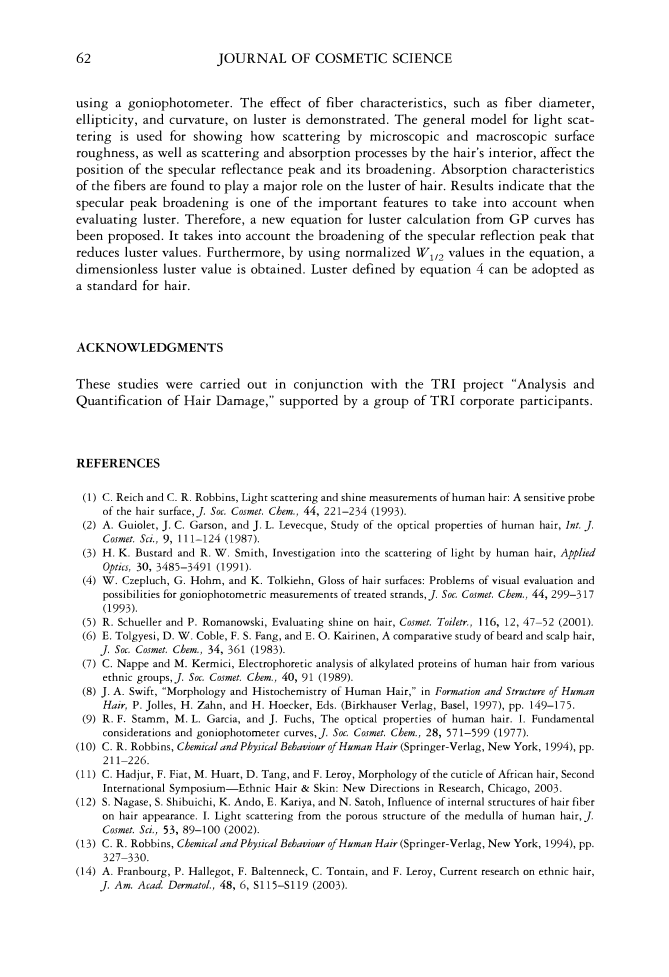LIGHT SCATTERING FROM ETHNIC HAIR FIBERS 61 0.4 0.3 0.2 · C 0.1 C 0.0 -0.1 0 20 40 60 80 Scattering angle Figure 9. Goniophotometric intensity scan under He-Ne laser illumination for a standard black mirror from Hunter Lab. Hair origin Piedmont Light brown European Dark brown European Indian Japanese Chinese African -American Table II Luster Calculated by Equations 1 and 4 Luster(%) by equation 1 (He-Ne laser illumination) 17.35 21.53 27.91 35.6 34.25 24.05 35.95 Luster(%) by equation 4 (He-Ne laser illumination) 8.4 12.6 17.8 27.2 19.1 15.7 20.8 The luster values calculated from equations 1 and 4 are given in Table II. The absolute luster values calculated by equation 4 progressively decrease because of the nature of this equation. However, we note that there are comparable changes in the luster values calculated using equations 1 and 4 for European hair with various pigmentation levels. This indicates that in the case of European hair the peak broadening is dominantly caused by a gradual decrease in pigmentation, leading to increased scattering by the hair's interior. However, for hair of Asian origin the use of the latter equation differ entiates similar luster values (e.g., Indian and Japanese hair) obtained by using equation 1. Hence, equation 4 is more discriminating. For hair with Asian origin the pigmen tation is similar, and therefore the peak broadening should be explained by differences in the hair's internal structure, e.g., the presence or absence of the medulla. Japanese hair is known to have a high medullation, leading to increased internal light scattering. SUMMARY In this study the optical properties of hair from various ethnic backgrounds are studied
62 JOURNAL OF COSMETIC SCIENCE using a goniophotometer. The effect of fiber characteristics, such as fiber diameter, ellipticity, and curvature, on luster is demonstrated. The general model for light scat tering is used for showing how scattering by microscopic and macroscopic surface roughness, as well as scattering and absorption processes by the hair's interior, affect the position of the specular reflectance peak and its broadening. Absorption characteristics of the fibers are found to play a major role on the luster of hair. Results indicate that the specular peak broadening is one of the important features to take into account when evaluating luster. Therefore, a new equation for luster calculation from GP curves has been proposed. It takes into account the broadening of the specular reflection peak that reduces luster values. Furthermore, by using normalized W112 values in the equation, a dimensionless luster value is obtained. Luster defined by equation 4 can be adopted as a standard for hair. ACKNOWLEDGMENTS These studies were carried out in conjunction with the TRI project "Analysis and Quantification of Hair Damage," supported by a group of TRI corporate participants. REFERENCES (1) C. Reich and C. R. Robbins, Light scattering and shine measurements of human hair: A sensitive probe of the hair surface,]. Soc. Cosmet. Chem., 44, 221-234 (1993). (2) A. Guiolet, J. C. Garson, and J. L. Levecque, Study of the optical properties of human hair, Int. J. Cosmet. Sci., 9, 111-124 (1987). (3) H. K. Bustard and R. W. Smith, Investigation into the scattering of light by human hair, Applied Optics, 30, 3485-3491 (1991). (4) W. Czepluch, G. Hohm, and K. Tolkiehn, Gloss of hair surfaces: Problems of visual evaluation and possibilities for goniophotometric measurements of treated strands,]. Soc. Cosmet. Chem., 44, 299-317 (1993). (5) R. Schueller and P. Romanowski, Evaluating shine on hair, Cosmet. Toiletr., 116, 12, 47-52 (2001). (6) E. Tolgyesi, D. W. Coble, F. S. Fang, and E. 0. Kairinen, A comparative study of beard and scalp hair, J. Soc. Cosmet. Chem., 34, 361 (1983). (7) C. Nappe and M. Kermici, Electrophoretic analysis of alkylated proteins of human hair from various ethnic groups,]. Soc. Cosmet. Chem., 40, 91 (1989). (8) J. A. Swift, "Morphology and Histochemistry of Human Hair," in Formation and Structure of Human Hair, P. Jolles, H. Zahn, and H. Hoecker, Eds. (Birkhauser Verlag, Basel, 1997), pp. 149-175. (9) R. F. Stamm, M. L. Garcia, and J. Fuchs, The optical properties of human hair. I. Fundamental considerations and goniophotometer curves,]. Soc. Cosmet. Chem., 28, 571-599 (1977). (10) C.R. Robbins, Chemical and Physical Behaviour of Human Hair (Springer-Verlag, New York, 1994), pp. 211-226. (11) C. Hadjur, F. Fiat, M. Huart, D. Tang, and F. Leroy, Morphology of the cuticle of African hair, Second International Symposium-Ethnic Hair & Skin: New Directions in Research, Chicago, 2003. (12) S. Nagase, S. Shibuichi, K. Ando, E. Kari ya, and N. Satoh, Influence of internal structures of hair fiber on hair appearance. I. Light scattering from the porous structure of the medulla of human hair, J. Cosmet. Sci., 53, 89-100 (2002). (13) C.R. Robbins, Chemical and Physical Behaviour of Human Hair (Springer-Verlag, New York, 1994), pp. 327-330. (14) A. Franbourg, P. Hallegot, F. Baltenneck, C. Tontain, and F. Leroy, Current research on ethnic hair, J. Am. Acad Dermatol., 48, 6, S115-S119 (2003).
Purchased for the exclusive use of nofirst nolast (unknown) From: SCC Media Library & Resource Center (library.scconline.org)





































































































































